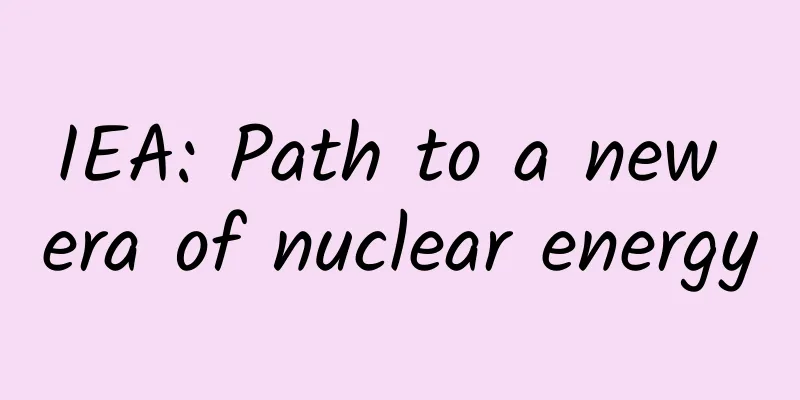IEA: Path to a new era of nuclear energy

|
The IEA has released a new report, “The Road to a New Era of Nuclear Energy”. There are many signs that a new era of nuclear energy is coming. The market, technology and policy foundations for the new era of nuclear energy development in the coming decades are already in place. Nuclear power generation to reach record high by 2025 The world's nearly 420 reactors are expected to generate new electricity by 2025. Some 63 nuclear reactors with a capacity of more than 70 gigawatts are currently under construction, one of the highest levels since 1990. Momentum behind nuclear energy is uneven Currently, the new momentum behind nuclear energy relies heavily on Chinese and Russian technology. The shift in market leadership is already happening: half of the nuclear power projects currently under construction are in China, and China's nuclear power installed capacity is expected to surpass that of the United States and the European Union by 2030. A bright future for nuclear energy is open to the public, as regional outcomes vary widely across scenarios based on today’s policy environment and market dynamics. Small modular reactors could be a catalyst for change Driven by government support and new business models, cost-competitive small reactors could help clear the path to a new era of nuclear energy. If construction costs for small reactors were to fall to the same level as large reactors built on budget over the next 15 years, the cost-effectiveness of small reactors would increase by a further 60%, with deployment expected to reach 190 GW in 2050. Technology leadership and supply chain diversification The rise of small reactors, combined with a new wave of large reactors built on time and on budget, makes it possible for Europe, the United States, and Japan to regain technological leadership. A more diverse supply of uranium and enrichment services is essential for the safe and affordable expansion of the nuclear sector. Mobilizing new sources of funding The rapid growth scenario requires a significant increase in annual investment, which is expected to double to $120 billion by 2030. Public funding alone will not be enough to usher in a new era of nuclear energy: private investment is needed. Ensure better understanding of time and cash flow Reducing the risk of cost overruns and delays is a prerequisite for expanding public and private finance and protecting consumer interests. Predictability of future cash flows is key to reducing financing costs and attracting private capital into the nuclear energy industry. SMEs bring new business models Small reactors could significantly reduce the overall investment cost of a single project to levels similar to large renewable energy projects such as offshore wind and large hydropower. Government leadership in the new nuclear energy era Governments are uniquely positioned to provide the strategic vision, policies, incentives and public finance to move the nuclear energy sector forward.
|
>>: Huang Renxun may visit Shanghai on June 6. Is there hope for large model companies in China?
Recommend
12 Best Strategies for Attracting and Retaining App Users
As more and more companies create independently b...
Retention or virus? What should a product focus on in its early stages?
Many companies ask the question “How do we acquir...
How to improve the effective conversion rate when running advertisements?
In the process of search advertising , many corpo...
How to promote products through operational means?
Abstract: Today we are talking about push, which ...
Huang Daozhu's second issue of "Copyright-free Virtual Course Project 2.0"
First of all, let me tell you what this virtual c...
SEM promotion: How important is the idea? 80% of bidders die on this!
After reading this article, you can improve in th...
One million vehicles recalled, sales down 34.8%, Dongfeng Nissan may no longer be "far ahead"
Dongfeng Nissan used to be a far-leading player i...
Academician Wu Xinzhi: Spending a lifetime to get closer to the truth
The following article is from China Science Daily...
The entire process of new product launch promotion plan!
Table of contents: Chapter 1: Industry Background...
Among the three major Japanese car companies, why was Nissan the first to transform, rather than Honda or Toyota?
As the global automotive industry faces unprecede...
All models are equipped with high-end intelligent driving as standard, and the laser radar is not charged extra! Song L EV Intelligent Driving Edition starts at 189,800 yuan
On February 10, the Song L EV Smart Driving Editi...
How to use content to grow products?
Let me explain it simply and literally. What does...
Brain-computer interface technology helps humans realize "mind communication", how far are we from the cyborg world?
After a stroke, brain damage leads to limb paraly...
Product operation strategy: How to carry out user stratification operations?
Pyramid stratification is a method of stratifying...
Do people with photographic memories really exist?
© Genetic Literacy Project Leviathan Press: The w...









